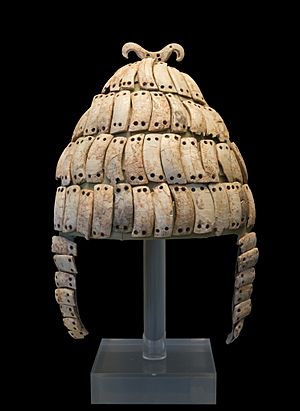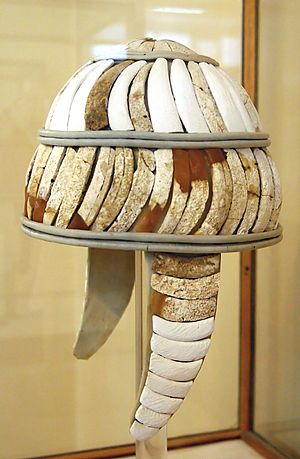Boar's tusk helmet facts for kids
Boar tusk helmets were a special type of helmet used in ancient Greece. They were worn by warriors during the Mycenaean period, a long time ago. These helmets were not made of metal, but from the strong tusks of wild boars. They were a unique part of ancient armor.
Contents
Boar Tusk Helmets: Ancient Armor
What Were These Helmets Made Of?
Boar tusk helmets were used in the Mycenaean world. This was a period in ancient Greece, from about 1600 BC to 1100 BC. These helmets were known from the 17th century BC until the 10th century BC.
The helmets were built in a clever way. Small pieces, called slivers, of boar tusks were used. These slivers were attached to a strong leather base. Inside, the helmet was padded with soft felt for comfort. The tusk pieces were arranged in neat rows all around the helmet.
Archaeologists have found parts of these helmets. For example, fragments were found at a place called Dendra. These pieces were found with other ancient armor. An old ivory carving also shows what these helmets looked like.
Helmets in Ancient Stories
These special helmets even appear in famous ancient stories. One example is in The Iliad, a very old Greek poem by Homer. In the story, the hero Odysseus gets ready for a secret night mission. He needs a good helmet for his raid against the Trojans.
The poem describes the helmet given to Odysseus:
Meriones gave Odysseus a bow, a quiver and a sword, and put a cleverly made leather helmet on his head. On the inside there was a strong lining on interwoven straps, onto which a felt cap had been sewn in. The outside was cleverly adorned all around with rows of white tusks from a shiny-toothed boar, the tusks running in alternate directions in each row.
Homer's story also says that this helmet was an heirloom. This means it was passed down through a family for many years. This detail shows how valuable and important these helmets were.
Why Were They Special?
Boar tusk helmets might not have been as strong as metal helmets. They probably did not offer the best protection in a fight. However, they were likely worn by important leaders. They could have been a way to show high status or rank. They might also have helped identify leaders on the battlefield.
Making one of these helmets was a huge task. It needed many boar tusks. Experts believe that forty to fifty boars had to be hunted. This would provide enough tusks for just one helmet. The number of tusk plates on a helmet could vary. Some helmets might have had 40 plates, while others had up to 140. This shows how much effort went into creating each one.
See also
- Military of Mycenaean Greece
- Germanic boar helmets



